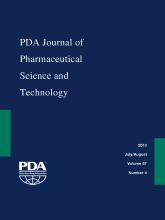Abstract
This report deals with the construction and management of the reverse osmosis (RO) water system for final rinsing of surgical instruments in the washer-disinfector. Numerous operational challenges were encountered in our RO water system and these were analyzed utilizing the Ishikawa Fishbone diagram. The aim was to find potential problems and promote preventive system management for RO water. It was found that the measures that existed were inappropriate for preventing contamination in the heat-labile RO water system. The storage tank was found to be significantly contaminated and had to be replaced with a new one equipped with a sampling port and water drainage system. Additional filters and an UV treatment lamp were installed. The whole system disinfection started 1.5 years later using a peracetic acid–based compound after confirming the material compatibility. Operator errors were found when a new water engineer took over the duty from his predecessor. It was also found that there were some deficiencies in the standard operating procedures (SOPs), and that on-the-job training was not enough. The water engineer failed to disinfect the sampling port and water drainage system. The RO membrane had been used for 4 years, even though the SOP standard specified changing it as every 3 years. Various bacteria, such as Rothia mucilaginosa, were cultured from the RO water sampled from the equipment. Because Rothia mucilaginosa is a resident in the oral cavity and upper respiratory tract, it is believed that the bacteria were introduced into the system by the maintenance personnel or working environment. Therefore, the presence of R. mucilaginosa implied the failure of sanitary maintenance procedures. This study suggests that water systems should be designed based on the plans for profound system maintenance. It also suggests that SOP and on-the job training are essential to avoid any operator errors. These results must be carefully considered when either constructing new RO systems or performing maintenance and periodical examination of the equipment.
LAY ABSTRACT: Reverse osmosis (RO) water is used for final rinsing in our washer-disinfector. The authors used the Ishikawa Fishbone diagram to clarify the critical points for optimizing RO water quality. There existed no measures to prevent contamination in the heat-labile RO water system. The storage tank was significantly contaminated and had to be replaced with a new one equipped with a sampling port and water drainage system. Additional filters and an UV treatment lamp were installed. The whole system disinfection started 1.5 years later using a peracetic acid–based compound after confirming the material compatibility. Operator errors occurred when a new water engineer took over the duty from his predecessor. There were neither standard operating procedures (SOPs) nor on-the-job training. The new water engineer had failed to disinfect the sampling port and water drainage system. Rothia mucilaginosa was cultured from the RO water. It is a resident in the oral cavity and upper respiratory tract. This implied the possible failure of sanitary procedures in the system maintenance. The Ishikawa Fishbone diagram was useful for this study. It suggests that water systems should be designed with plans for system maintenance taken into account. It also suggests that SOP and on-the job training are essential in order to avoid operator errors.
- © PDA, Inc. 2013
PDA members receive access to all articles published in the current year and previous volume year. Institutional subscribers received access to all content. Log in below to receive access to this article if you are either of these.
If you are neither or you are a PDA member trying to access an article outside of your membership license, then you must purchase access to this article (below). If you do not have a username or password for JPST, you will be required to create an account prior to purchasing.
Full issue PDFs are for PDA members only.
Note to pda.org users
The PDA and PDA bookstore websites (www.pda.org and www.pda.org/bookstore) are separate websites from the PDA JPST website. When you first join PDA, your initial UserID and Password are sent to HighWirePress to create your PDA JPST account. Subsequent UserrID and Password changes required at the PDA websites will not pass on to PDA JPST and vice versa. If you forget your PDA JPST UserID and/or Password, you can request help to retrieve UserID and reset Password below.






